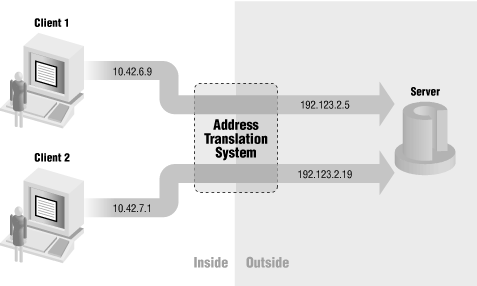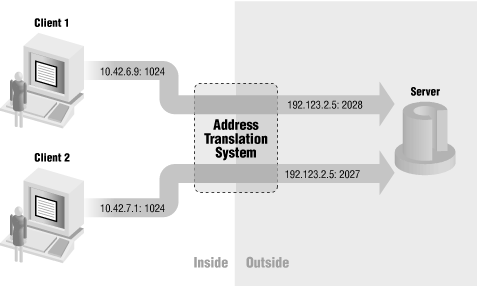
 |  |
5.4. Network Address Translation
Network address translation (NAT) allows a network to use one set of network addresses internally and a different set when dealing with external networks. Network address translation does not, by itself, provide any security, but it helps to conceal the internal network layout and to force connections to go through a choke point (because connections to untranslated addresses will not work, and the choke point does the translation).Like packet filtering, network address translation works by having a router do extra work. In this case, not only does the router send packets on, but it also modifies them. When an internal machine sends a packet to the outside, the network address translation system modifies the source address of the packet to make the packet look as if it is coming from a valid address. When an external machine sends a packet to the inside, the network address translation system modifies the destination address to turn the externally visible address into the correct internal address. The network address translation system can also modify the source and destination port numbers (this is sometimes called Port and Address Translation or PAT). Figure 5-3 shows a network address translation system modifying only addresses, while Figure 5-4 shows port and address translation.

Figure 5-3. Network address translation

Figure 5-4. Port and address translation
Network address translation systems can use different schemes for translating between internal and external addresses:
- Allocate one external host address for each internal address and always apply the same translation. This provides no savings in address space, and it slows down connections; it is normally a temporary measure used by sites that have been using illegal address spaces but are in the process of moving to using valid addresses.
- Dynamically allocate an external host address each time an internal host initiates a connection, without modifying port numbers. This limits the number of internal hosts that can simultaneously access the Internet to the number of available external addresses.
- Create a fixed mapping from internal addresses to externally visible addresses, but use port mapping so that multiple internal machines use the same external addresses.
- Dynamically allocate an external host address and port pair each time an internal host initiates a connection. This makes the most efficient possible use of the external host addresses.
5.4.1. Advantages of Network Address Translation
The main purpose of network address translation is to economize on address space, but it can also have some security advantages.5.4.1.1. Network address translation helps to enforce the firewall's control over outbound connections
Since individual hosts have addresses that won't work on the external network, they require the assistance of the network address translation system to connect. If a host finds a way to connect to the Internet without going through the address translation, the connection won't work.
5.4.1.2. Network address translation can help restrict incoming traffic
Depending on how you configure a network address translation system, it can provide stronger restrictions on incoming traffic than packet filtering. A network address translation system that's doing dynamic translation will allow only packets that are part of a current interaction initiated from the inside. This is similar to the protection that a dynamic packet filter offers, but the changing IP addresses put stronger time constraints on attackers. Not only can they attack only certain ports, but if they wait too long, the address translation will have gone away, and the entire address will have disappeared or been given to another host.any people assume that all network address translation systems provide this sort of protection, but this is not true. If you configure a network address translation system to do static translations, it may provide no restrictions at all on incoming traffic. Even doing dynamic translations, the simplest implementations allocate an entire externally visible address to the internal host and translate all traffic sent to that address. This does limit the time that an attacker has, but otherwise provides no protection at all.
5.4.1.3. Network address translation helps to conceal the internal network's configuration
The less an attacker knows about you, the better off you are. A network address translation system makes it much more difficult for an attacker to determine how many computers you have, what kind of machines they are, and how they're arranged on the network. Note, however, that many protocols leak useful information (for instance, they may include the client's IP address or hostname in places where the network address translation system doesn't need to change it). When we discuss the network address translation properties of protocols, we attempt to mention leaks of this sort.
5.4.2. Disadvantages of Network Address Translation
While network address translation is a very useful way of conserving network address space, it presents some problems.5.4.2.1. Dynamic allocation requires state information that is not always available
It is very easy for a network address translation system to tell whether or not a host has stopped using a TCP connection, but there's no way to know at the packet header level whether a UDP packet is part of an ongoing conversation or is an isolated event. This means that a network address translation system has to guess how long it should keep a particular translation. If it guesses incorrectly, responses may be lost or delivered to unexpected hosts.
5.4.2.2. Embedded IP addresses are a problem for network address translation
Network address translation systems normally translate the addresses in the headers of packets (see Chapter 4, "Packets and Protocols ", for more information about packet layout). Some protocols also hide addresses in other places, and in order to find those addresses, the network address translator has to understand the protocol enough to find and modify the address, while preserving the validity of the packet. Most network address translation systems are capable of doing this for at least some protocols (for instance, FTP) but not for all protocols.
5.4.2.3. Network address translation interferes with some encryption and authentication systems
Systems for encrypting data often attempt to ensure the integrity of the data, so that the systems that are communicating know that packets have not been tampered with in transit. Network address translation is a form of tampering with the data in transit. If the protocol that's being translated does not protect the data that the network address translation system modifies, it will work. Otherwise, the integrity checking will be violated, and connections will fail. In most cases, protocols that do not have embedded IP addresses are compatible (the packet headers are not part of the protocol's protected data). The major exception to this rule is IPsec, which protects the entire packet, including headers. Network address translation is almost guaranteed to fail for protocols that combine embedded IP addresses with data integrity protection.
5.4.2.4. Dynamic allocation of addresses interferes with logging
If you are logging information after the network address translation happens, the logs will show the translated addresses, and you will have to correlate the logs with information from the network address translation system to figure out what internal system is actually involved. For instance, if you have a screened subnet architecture (discussed in Chapter 6, "Firewall Architectures"), and you are doing network address translation on the interior router, the translated addresses will be in logs from the exterior router or from a caching web proxy server on the screened subnet. Although log correlation is theoretically possible, it may be difficult, and clock synchronization will be critical.
5.4.2.5. Dynamic allocation of ports may interfere with packet filtering
Packet filtering systems pay attention to source and destination port numbers in order to try to figure out what protocol a packet should be using. Changing the source port may change the packet's acceptability. In most cases, this is not a problem because address translation systems are translating for clients, which are usually allowed to use any port above 1023. However, if ports above 1023 are translated to ports below 1023, traffic may be dropped.


